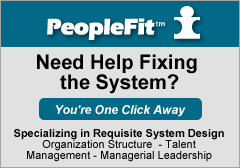Structural Failures within Organizations – Close is Not Good Enough
By Michelle Malay Carter on June 17, 2008
 Steve Roesler throws out the concept of applied management in his latest post?on employee survey research.? I couldn’t agree more that we need more applied management within organizations.
Steve Roesler throws out the concept of applied management in his latest post?on employee survey research.? I couldn’t agree more that we need more applied management within organizations.
And I would ask, just what are we applying?
Is Close Good Enough?
Engineers take natural laws and science-based knowledge and use this inform to inform their designs.? If I need to build something that can bear 1000 pounds of weight, I dare not choose a building material that bears 950 pounds.? It’s just a little off, but it’s a mistake that could have devastating consequences.? Close is simply not good enough.
Requisite Design – Requisite Means As Called for by the Nature of Things
Until we understand and apply the natural laws surrounding work complexity and human capability, we will continue to suffer “structural failures” within organizations, and our employees, managers, and organizations will continue to?suffer the consequences of this ignorance.
Matching People to Jobs – When Close Isn’t Good Enough
If I have a level 2 job (which can be scientifically measured using time span of discretion), and I fill it with someone currently capable of high level 1 work (which can be assessed as well), it’s very close, but the person will not be capable of performing level 2 work at this time.?
Structural Failure
The result is?a “structural failure” which will impact the employee, the manager, and obviously the organization.
Structural Failures Often Masquerade as Competency and Personality Issues
My consulting work is rooted in pointing out structural failures to clients.? Structural failures often masquerade as personality conflicts, attitude problems, and incompetence.? As long as we continue to view them this way, the answer will be to fix the people.? How is that going for you?? Have you read your employee engagement survey results?
I’m OK.? You’re OK.? Let’s Fix the System(s)
As you know, I will argue that the system has failed in this case of mis-hiring.? First, the job design system is not science-based and without a much needed measurement component for role complexity level,?and the candidate screening process fails to screen for cognitive capability level.?
One in Three Employees is Mismatched to His Role
PeopleFit research shows that 35% of employees are mismatched to their roles.? We have a structural failure rate of 35% on this one factor alone.?
Save the Planet!
Would you ride in an elevator that had a structural failure rate of 35%?? How about 0.35%?? Yet, many of us spend five days a week optimistically?”giving our lives over to organizations” that suffer from severe structural failures.? If you don’t think that depression, stress, abuse, and all forms of mental illness are not fueled by this reality, you’re missing the big picture.
Have you suffered from a structural failure within an organization?
Filed Under Employee Engagement, Executive Leadership, Managerial Leadership, Organization Design, Requisite Organization, Strategy, Talent Management, Work Levels
Comments
7 Responses to “Structural Failures within Organizations – Close is Not Good Enough”

Hi Michelle,
Yes it is a problem that we under-engineer work environments and structures.
Typically, the engineer, first decides that weight bearing strength of 1000lbs is necessary, then adds 50% for security. Next, they choose the best material to carry the strain. Then, they make over-abundant connections so that should any fail, there will be back-up. This is followed by the installation of a safety net underneath.
But as for people? Well, they can sink or swim!
As an ex HR director, I was always disappointed that Recruitment and Selection were perceived to be among the lower status jobs in the function. The high status jobs were OD, Employee Relations, Training, etc. But the people who did those apparently more glamorous jobs were often deployed on fixing the problems that were created by ineffective recruitment of the right folk!
What if we….. established workers, offered them 50% more training than they needed, doubled their connections inside the organisation, built safety nets underneath them and checked that they were carrying the weight? We might do better. That would be engineering with an attitude!
Jack,
I love it! What a great place that would be! I’m all for engineering with an attitude.
Regards,
Michelle
Michelle – Great post
Do you find that by identifying the cognitive shortcomings of a candidate a personal development plan can be designed to address these shortcomings?
I am curious – is one stuck at a given level of cognitive ability or have you found through your experiences that there does exist room for cognitive improvement whereby one can move up to the next job level – say level 2 to level 3?
Be Well!
-Chris Young
Hi Chris,
If a person is found to be underperforming in a role due to a lack of knowledge, skills or experience, personal development – coaching, training, education can remedy this.
If a person is underperforming in a role due to the fact that they are not yet cognitively capable of problem solving and working at the time horizons associated with the level of work of the role, then we must wait until the person matures into the level of cognitive capability called for by the role.
Cognitive capacity is a generic ability to problem solve which is present in discreet levels. It can be thought of as mental bandwidth or mental horsepower. It has to do with the way a person organizes and uses information to make decisions and solve problems. Some people are able to “contain”, grapple with, and apply both greater volumes and more complex and abstract information toward their decision making and problem solving.
For example, some people’s personal financial planning takes into account 10 and 20 year global trend analysis, emerging economies, anticipated collapses in certain markets or sectors, etc. Others’ financial planning process is solely related to the amount of money in their next paycheck. Could we close the gap between person one and person two with training, education and technology?
Some basic budgeting and finance training and technology (software) might help person 2 some, but it will never get them to wake up one morning and be able to problem solve via global trend analysis. These are examples between two extremes in problem solving capability, there are incremental steps in between.
So to address your question about whether cognitive capability is static or not: Cognitive ability matures with age throughout the course of our lives. For reasons unknown, some people mature in capability at a faster pace than others. The research has not shown a correlation between education, socioeconomic status, or experience.
Additionally, longitudinal research has produced cognitive maturation curves which can fairly accurately predict individual maturation rates. So if you know where a person is today, and you know their age, from that, you can predict when a person will be maturing into capability at the next level and will be ready for more challenging work.
So, personal development planning can be greatly informed by understanding this as far as future potential and what type of training and development to offer when.
Hope this helps. It’s a paradigm shift, and this information can really set people off so I usually don’t lead with it in my posts.
Regards,
Michelle
Wow. Great expansion on the topic in response to Chris Young’s comment!
The use of the term “cognitive horsepower” made me realize that an analagous term in endurance athletics would be VO2max, also referred to as aerobic horsepower. While aerobic horsepower can be increased to a degree by specific physical training, the ceiling can be reached fairly quickly and is genetically determined. Past that point, no amount of training will further enhance aerobic horsepower, although training will improve specific addressed efficiencies and other technical skills. Aerobic horsepower is a large determinant of the peak performance potential of an athlete. The top performing athletes must have all of these– technical skills, efficiencies, as well as outstanding aerobic horsepower. One of these is genetically pre-determined. It’s a popular saying in endurance athletics that the best way to improve VO2max is to choose your parents wisely.
While most are comfortable acknowledging that such physical limits are genetically determined, most aren’t as comfortable admitting the same thing with cognitive horsepower. Whether many want to believe it or not, I think that we end up with a similar situation between level of work performance and level of athletic performance– you have the horsepower or you don’t. No amount of training and coaching can change that. You can, however, be limited in fully exercising your horsepower by lacking efficiencies and technical skills. These are what can be addressed with training and coaching.
Hi Alicia,
Yes, for some reason we are more willing to accept the idea of physical limitations but not cognitive ones.
Most people won’t argue with the fact that no matter how hard they tried, they would not be able to play basketball like Michael Jordan, but they want to believe everyone could be president if they wanted to.
Thanks for the comment.
Michelle
[…] Fallow had this to say about my lamentation on organizational structural failures:? Yes it is a problem that we under-engineer work environments and […]